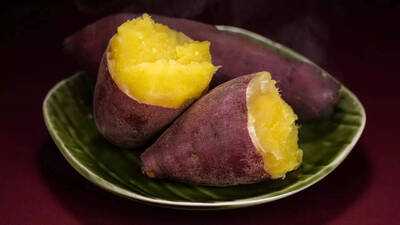Looking for a healthier alternative to regular potatoes? Then sweet potatoes make for a perfect choice. But what about the starch and carbs? Well, this may be disappointing for people who swear by sweet potatoes—assuming them to be the healthiest alternative to potatoes—that this root veggie is also loaded with starch and sugar, which may not be a great choice for a healthy diet. However, by removing the excess starch from sweet potatoes, one can easily add them to a healthy diet plan—without experiencing sugar spikes and excessive calorie uptake. Here are five effective ways to remove or reduce excessive starch from sweet potatoes.
Soaking in Cold Water
One of the simplest methods to reduce starch is to peel and cut sweet potatoes, then soak them in a bowl of cold water for at least 30 minutes to 2 hours. This draws out a good amount of surface starch. For best results, change the water once or twice during soaking. You'll notice the water becoming cloudy—that’s the starch being released.

Rinsing Under Running Water
After cutting sweet potatoes, rinse them thoroughly under cold running water for several minutes. Agitating the pieces with your hands while rinsing helps wash off loose starch on the surface. This quick method is especially useful before frying or roasting to prevent them from becoming too sticky or soggy.
Parboiling Before Cooking
Parboiling involves partially boiling sweet potato pieces for 5–7 minutes, then draining and rinsing them. This process not only helps release internal starch but also improves the texture if you’re planning to bake or roast them. Make sure to discard the starchy water after boiling.
Using a Salt Water Soak
Soaking sweet potatoes in salted water (about 1 tablespoon of salt per liter of water) for 30–45 minutes can be more effective than plain water in drawing out starch. The salt helps break down some of the surface starches and gives the sweet potatoes a firmer texture—especially useful for frying or achieving crispier results.

Blanching and Drying
For recipes that require crispy or light-textured sweet potatoes, blanching (brief boiling followed by an ice water bath) works well. After blanching, dry the sweet potatoes thoroughly with a clean cloth or paper towel. This technique helps remove both surface and internal starch while locking in nutrients and preventing excess sogginess during cooking.
Soaking in Cold Water
One of the simplest methods to reduce starch is to peel and cut sweet potatoes, then soak them in a bowl of cold water for at least 30 minutes to 2 hours. This draws out a good amount of surface starch. For best results, change the water once or twice during soaking. You'll notice the water becoming cloudy—that’s the starch being released.

Rinsing Under Running Water
After cutting sweet potatoes, rinse them thoroughly under cold running water for several minutes. Agitating the pieces with your hands while rinsing helps wash off loose starch on the surface. This quick method is especially useful before frying or roasting to prevent them from becoming too sticky or soggy.
Parboiling Before Cooking
Parboiling involves partially boiling sweet potato pieces for 5–7 minutes, then draining and rinsing them. This process not only helps release internal starch but also improves the texture if you’re planning to bake or roast them. Make sure to discard the starchy water after boiling.
Using a Salt Water Soak
Soaking sweet potatoes in salted water (about 1 tablespoon of salt per liter of water) for 30–45 minutes can be more effective than plain water in drawing out starch. The salt helps break down some of the surface starches and gives the sweet potatoes a firmer texture—especially useful for frying or achieving crispier results.
Blanching and Drying
For recipes that require crispy or light-textured sweet potatoes, blanching (brief boiling followed by an ice water bath) works well. After blanching, dry the sweet potatoes thoroughly with a clean cloth or paper towel. This technique helps remove both surface and internal starch while locking in nutrients and preventing excess sogginess during cooking.
You may also like

Luke Littler shares dream sports event he wants to play in but fears breaking his arm

Outdated office gadgets workers are glad to see the back of

Bhopal: 23% Conviction Rate In SC/ST Atrocity Cases

Madhya Pradesh: Simhastha 2028 Preparations; Collector Begins From Ujjain Junction

Strictly Come Dancing 'sign Ellie Goldstein' after she 'breaks barriers'





